Prognostic Nutritional Index after Chemoradiotherapy Was the Strongest Prognostic Predictor among Biological and Conditional Factors in Localized Pancreatic Ductal Adenocarcinoma Patients
Abstract
:1. Introduction
2. Materials and Methods
2.1. CRT Protocol and Reassessment
2.2. Indication for Pancreatectomy and Surgical Procedure
2.3. Postoperative Treatment and Follow-Up
2.4. Assessment of Anatomical, Biological, and Conditional Factors Before and After CRT
2.5. Statistical Analysis
3. Results
3.1. Patient Characteristics
3.2. Univariate and Multivariate Analyses of Factors Contributing to DSS
3.3. Comparisons of DSS Based on Each Significant Prognostic Factor Identified in Multivariate Analysis
3.4. Role of Post-CRT PNI in Determining the Indication for Surgery
3.5. Patients Characteristics between Post-CRT PNI ≥ 39 and PNI < 39
4. Discussion
5. Conclusions
Author Contributions
Funding
Conflicts of Interest
References
- Tinkl, D.; Grabenbauer, G.G.; Golcher, H.; Meyer, T.; Papadopoulos, T.; Hohenberger, W.; Sauer, R.; Brunner, T.B. Downstaging of pancreatic carcinoma after neoadjuvant chemoradiation. Strahlenther. Onkol. 2009, 185, 557–566. [Google Scholar] [CrossRef]
- Isaji, S.; Mizuno, S.; Windsor, J.A.; Bassi, C.; Fernández-Del Castillo, C.; Hackert, T.; Hayasaki, A.; Katz, M.H.G.; Kim, S.W.; Kishiwada, M.; et al. International consensus on definition and criteria of borderline resectable pancreatic ductal adenocarcinoma 2017. Pancreatology 2018, 18, 2–11. [Google Scholar] [CrossRef]
- Hayasaki, A.; Isaji, S.; Kishiwada, M.; Fujii, T.; Iizawa, Y.; Kato, H.; Tanemura, A.; Murata, Y.; Azumi, Y.; Kuriyama, N.; et al. Survival analysis in patients with pancreatic ductal adenocarcinoma undergoing chemoradiotherapy followed by surgery according to the international consensus on the 2017 definition of borderline resectable cancer. Cancers 2018, 10, 65. [Google Scholar] [CrossRef]
- Garcea, G.; Ladwa, N.; Neal, C.P.; Metcalfe, M.S.; Dennison, A.R.; Berry, D.P. Preoperative neutrophil-to-lymphocyte ratio (NLR) is associated with reduced disease-free survival following curative resection of pancreatic adenocarcinoma. World J. Surg. 2011, 35, 868–872. [Google Scholar] [CrossRef]
- Smith, R.A.; Bosonnet, L.; Raraty, M.; Sutton, R.; Neoptolemos, J.P.; Campbell, F.; Ghaneh, P. Preoperative platelet-lymphocyte ratio is an independent significant prognostic marker in resected pancreatic ductal adenocarcinoma. Am. J. Surg. 2009, 197, 466–472. [Google Scholar] [CrossRef]
- Wu, M.; Guo, J.; Guo, L.; Zuo, Q. The C-reactive protein/albumin ratio predicts overall survival of patients with advanced pancreatic cancer. Tumour. Biol. 2016, 37, 12525–12533. [Google Scholar] [CrossRef]
- Jamieson, N.B.; Denley, S.M.; Logue, J.; MacKenzie, D.J.; Foulis, A.K.; Dickson, E.J.; Imrie, C.W.; Carter, R.; Mckay, C.J.; McMillan, D.C. A prospective comparison of the prognostic value of tumor- and patient-related factors in patients undergoing potentially curative surgery for pancreatic ductal adenocarcinoma. Ann. Surg. Oncol. 2011, 18, 2318–2328. [Google Scholar] [CrossRef]
- Kanda, M.; Fujii, T.; Kodera, Y.; Nagai, S.; Takeda, S.; Nakao, A. Nutritional predictors of postoperative outcome in pancreatic cancer. Br. J. Surg. 2011, 98, 268–274. [Google Scholar] [CrossRef]
- Buzby, G.P.; Mullen, J.L.; Matthews, D.C.; Hobbs, C.L.; Rosato, E.F. Prognostic nutritional index in gastrointestinal surgery. Am. J. Surg. 1980, 139, 160–167. [Google Scholar] [CrossRef]
- Onodera, T.; Goseki, N.; Kosaki, G. Prognostic nutritional index in gastrointestinal surgery of malnourished cancer patients. Nippo. Geka Gakkai Zasshi 1984, 85, 1001–1005. (In Japanese) [Google Scholar]
- Kwon, W.A.; Kim, S.; Kim, S.H.; Joung, J.Y.; Seo, H.K.; Lee, K.H.; Chung, J. Pretreatment Prognostic Nutritional Index Is an Independent Predictor of Survival in Patients With Metastatic Renal Cell Carcinoma Treated With Targeted Therapy. Clin. Genitourin. Cancer. 2017, 15, 100–111. [Google Scholar] [CrossRef]
- Broggi, M.S.; Patil, D.; Baum, Y.; Nieh, P.T.; Alemozaffar, M.; Pattaras, J.G.; Ogan, K.; Master, V.A. Onodera’s Prognostic Nutritional Index as an Independent Prognostic Factor in Clear Cell Renal Cell Carcinoma. Urology 2016, 96, 99–105. [Google Scholar] [CrossRef]
- Mohri, T.; Mohri, Y.; Shigemori, T.; Takeuchi, K.; Itoh, Y.; Kato, T. Impact of prognostic nutritional index on long-term outcomes in patients with breast cancer. World J. Surg. Oncol. 2016, 14, 170. [Google Scholar] [CrossRef]
- Lee, S.H.; Chung, M.J.; Kim, B.; Lee, H.S.; Lee, H.J.; Heo, J.Y.; Kim, Y.J.; Park, J.Y.; Bang, S.; Park, S.W.; et al. The Significance of the Prognostic Nutritional Index for All Stages of Pancreatic Cancer. Nutr. Cancer 2017, 69, 512–519. [Google Scholar] [CrossRef]
- Jang, J.Y.; Han, Y.; Lee, H.; Kim, S.W.; Kwon, W.; Lee, K.H.; Oh, D.Y.; Chie, E.K.; Lee, J.M.; Heo, J.S.; et al. Oncological Benefits of Neoadjuvant Chemoradiation With Gemcitabine Versus Upfront Surgery in Patients With Borderline Resectable Pancreatic Cancer: A Prospective, Randomized, Open-label, Multicenter Phase 2/3 Trial. Ann. Surg. 2018, 268, 215–222. [Google Scholar] [CrossRef]
- Kobayashi, M.; Mizuno, S.; Murata, Y.; Kishiwada, M.; Usui, M.; Sakurai, H.; Tabata, M.; Ii, N.; Yamakado, K.; Inoue, H.; et al. Gemcitabine-based chemoradiotherapy followed by surgery for borderline resectable and locally unresectable pancreatic ductal adenocarcinoma: Significance of the CA19-9 reduction rate and intratumoral human equilibrative nucleoside transporter 1 expression. Pancreas 2014, 43, 350–360. [Google Scholar] [CrossRef]
- Yamada, R.; Mizuno, S.; Uchida, K.; Yoneda, M.; Kanayama, K.; Inoue, H.; Murata, Y.; Kuriyama, N.; Kishiwada, M.; Usui, M.; et al. Human equilibrative nucleoside transporter 1 expression in endoscopic ultrasonography-guided fine-needle aspiration biopsy samples is a strong predictor of clinical response and survival in the patients with pancreatic ductal adenocarcinoma undergoing gemcitabine-based chemoradiotherapy. Pancreas 2016, 45, 761–771. [Google Scholar]
- Isaji, S.; Kishiwada, M.; Kato, H. Surgery for borderline pancreatic cancer: The Japanese experience. In Multimodal Management of Borderline Resectable Pancreatic Cancer; Katz, M.H.G., Ahmad, S.A., Eds.; Springer International Publishing: Basel, Switzerland, 2016; pp. 265–287. [Google Scholar]
- Shirasaka, T.; Shimamato, Y.; Ohshimo, H.; Yamaguchi, M.; Kato, T.; Yonekura, K.; Fukushima, M. Development of a novel form of an oral 5-fluorouracil derivative (S-1) directed to the potentiation of the tumor selective cytotoxicity of 5-fluorouracil by two biochemical modulators. Anticancer Drugs 1996, 7, 548–557. [Google Scholar] [CrossRef]
- Ikeda, M.; Ioka, T.; Ito, Y.; Yonemoto, N.; Nagase, M.; Yamao, K.; Miyakawa, H.; Ishii, H.; Sato, K.; Furuse, J.; et al. A multicenter phase II trial of S-1 with concurrent radiation therapy for locally advanced pancreatic cancer. Int. J. Radiat. Oncol. Biol. Phys. 2013, 85, 163–169. [Google Scholar] [CrossRef]
- Mayahara, H.; Ito, Y.; Morizane, C.; Ueno, H.; Okusaka, T.; Kondo, S.; Murakami, N.; Morota, M.; Sumi, M.; Itami, J.; et al. Salvage chemoradiotherapy after primary chemotherapy for locally advanced pancreatic cancer: A single-institution retrospective analysis. BMC Cancer. 2012, 12, 609. [Google Scholar] [CrossRef]
- Murata, Y.; Mizuno, S.; Kishiwada, M.; Hamada, T.; Usui, M.; Sakurai, H.; Tabata, M.; Inoue, H.; Shiraishi, T.; Isaji, S. Impact of histological response after neoadjuvant chemoradiotherapy on recurrence-free survival in UICC-T3 pancreatic adenocarcinoma but not in UICC-T4. Pancreas 2012, 41, 130–136. [Google Scholar] [CrossRef]
- Murata, Y.; Hamada, T.; Kishiwada, M.; Ohsawa, I.; Mizuno, S.; Usui, M.; Sakurai, H.; Tabata, M.; Ii, N.; Inoue, H.; et al. Human equilibrative nucleoside transporter 1 expression is a strong independent prognostic factor in UICC T3-T4 pancreatic cancer patients treated with preoperative gemcitabine-based chemoradiotherapy. J. Hepatobiliary Pancreat. Sci. 2012, 19, 413–425. [Google Scholar] [CrossRef]
- Mizuno, S.; Isaji, S.; Tanemura, A.; Kishiwada, M.; Murata, Y.; Azumi, Y.; Kuriyama, N.; Usui, M.; Sakurai, H.; Tabata, M. Anterior approach to the superior mesenteric artery by using nerve plexus hanging maneuver for borderline resectable pancreatic head carcinoma. J. Gastrointest. Surg. 2014, 18, 1209–1215. [Google Scholar] [CrossRef]
- Eisenhauer, E.A.; Therasse, P.; Bogaerts, J.; Schwartz, L.H.; Sargent, D.; Ford, R.; Dancey, J.; Arbuck, S.; Gwyther, S.; Mooney, M.; et al. New Response evaluation criteria in solid tumors: Revised RECIST guideline (ver.1.1). Eur. J. Cancer 2009, 45, 228–247. [Google Scholar] [CrossRef]
- Japan Pancreas Society. Classification of Pancreatic Carcinoma, 4th ed.; Kanehara & Co., Ltd.: Tokyo, Japan, 2016; ISBN 978-4-307-20371-5. [Google Scholar]
- Sobin, L.H.; Gospodarowicz, M.K.; Wittekind, C. TNM Classification of malignant tumors (UICC international union against cancer), 7th ed.; Wiley-Blackwell: Oxford, UK, 2009; ISBN 978-1-4443-3241-4. [Google Scholar]
- Tempero, M.A.; Uchida, E.; Takasaki, H.; Burnett, D.A.; Steplewski, Z.; Pour, P.M. Relationship of carbohydrate antigen 19-9 and Lewis antigens in pancreatic cancer. Cancer Res. 1987, 47, 5501–5503. [Google Scholar]
- Oken, M.M.; Creech, R.H.; Tormey, D.C.; Horton, J.; Davis, T.E.; McFadden, E.T.; Carbone, P.P. Toxicity and response criteria of the eastern cooperative oncology group. Am. J. Clin. Oncol. 1982, 5, 649–655. [Google Scholar]
- Fairclough, E.; Cairns, E.; Hamilton, J.; Kelly, C. Evaluation of a modified early warning system for acute medical admissions and comparison with C-reactive protein/albumin ratio as a predictor of patient outcome. Clin. Med. 2009, 9, 30–33. [Google Scholar] [CrossRef]
- Al Murri, A.M.; Bartlett, J.M.; Canney, P.A.; Doughty, J.C.; Wilson, C.; McMillan, D.C. Evaluation of an inflammation-based prognostic score (GPS) in patients with metastatic breast cancer. Br. J. Cancer. 2006, 94, 227–230. [Google Scholar] [CrossRef]
- Proctor, M.J.; Morrison, D.S.; Talwar, D.; Balmer, S.M.; O’Reilly, D.S.; Foulis, A.K.; Horgan, P.G.; McMillan, D.C. An inflammation-based prognostic score (mGPS) predicts cancer survival independent of tumour site: A Glasgow Inflammation Outcome Study. Br. J. Cancer 2011, 104, 726–734. [Google Scholar] [CrossRef]
- Hartwig, W.; Strobel, O.; Hinz, U.; Fritz, S.; Hackert, T.; Roth, C.; Buchler, M.W.; Werner, J. CA 19-9 in potentially resectable pancreatic cancer: Perspective to adjust surgical and perioperative therapy. Ann. Surg. Oncol. 2013, 20, 2188–2196. [Google Scholar] [CrossRef]
- Hess, V.; Glimelius, B.; Grawe, P.; Dietrich, D.; Bodoky, G.; Ruhstaller, T.; Bajetta, E.; Saletti, P.; Figer, A.; Scheithauer, W.; et al. CA 19-9 tumour-marker response to chemotherapy in patients with advanced pancreatic cancer enrolled in a randomised controlled trial. Lancet Oncol. 2008, 9, 132–138. [Google Scholar] [CrossRef]
- Ni, X.G.; Bai, X.F.; Mao, Y.L.; Shao, Y.F.; Wu, J.X.; Shan, Y.; Wang, C.F.; Wang, J.; Tian, Y.T.; Liu, Q.; et al. The clinical value of serum CEA, CA 19-9, and CA242 in the diagnosis and prognosis of pancreatic cancer. Eur. J. Surg. Oncol. 2005, 31, 164–169. [Google Scholar] [CrossRef]
- Słotwiński, R.; Słotwińska, S.M. Diagnostic value of selected markers and apoptotic pathways for pancreatic cancer. Cent. Eur. J. Immunol. 2016, 41, 392–403. [Google Scholar] [CrossRef]
- Yasue, M.; Sakamoto, J.; Teramukai, S.; Morimoto, T.; Yasui, K.; Kuno, N.; Kurimoto, K.; Ohashi, Y. Prognostic values of preoperative and postoperative CEA and CA19.9 levels in pancreatic cancer. Pancreas 1994, 9, 735–740. [Google Scholar] [CrossRef]
- Zhou, G.; Liu, X.; Wang, X.; Jin, D.; Chen, Y.; Li, G.; Li, C.; Fu, D.; Xu, W.; Wang, X. Combination of preoperative CEA and CA 19-9 improves prediction outcomes in patients with resectable pancreatic adenocarcinoma: Results from a large follow-up cohort. Onco. Targets Ther. 2017, 10, 1199–1206. [Google Scholar] [CrossRef]
- Lee, K.J.; Yi, S.W.; Chung, M.J.; Park, S.W.; Song, S.Y.; Chung, J.B.; Park, J.Y. Serum CA 19-9 and CEA levels as a prognostic factor in pancreatic adenocarcinoma. Yonsei. Med J. 2013, 54, 643–649. [Google Scholar] [CrossRef]
- Tas, F.; Sen, F.; Odabas, H.; Kılıc, L.; Keskın, S.; Yıldız, I. Performance status of patients is the major prognostic factor at all stages of pancreatic cancer. Int. J. Clin. Oncol. 2013, 18, 839–846. [Google Scholar] [CrossRef]
- Simons, J.P.; Schols, A.M.; Buurman, W.A.; Wouters, E.F. Weight loss and low body cell mass in males with lung cancer: Relationship with systemic inflammation, acute-phase response, resting energy expenditure, and catabolic and anabolic hormones. Clin. Sci. (Lond) 1999, 97, 215–223. [Google Scholar] [CrossRef]
- O’Gorman, P.; McMillan, D.C.; McArdle, C.S. Impact of weight loss, appetite, and the inflammatory response on quality of life in gastrointestinal cancer patients. Nutr. Cancer 1998, 32, 76–80. [Google Scholar] [CrossRef]
- Barber, M.D.; Ross, J.A.; Fearon, K.C. Changes in nutritional, functional, and inflammatory markers in advanced pancreatic cancer. Nutr. Cancer. 1999, 35, 106–110. [Google Scholar] [CrossRef]
- McMillan, D.C.; Watson, W.S.; O’Gorman, P.; Preston, T.; Scott, H.R.; McArdle, C.S. Albumin concentrations are primarily determined by the body cell mass and the systemic inflammatory response in cancer patients with weight loss. Nutr Cancer 2001, 39, 210–213. [Google Scholar] [CrossRef]
- Szkandera, J.; Stotz, M.; Absenger, G.; Stojakovic, T.; Samonigg, H.; Kornprat, P.; Schaberl-Moser, R.; Alzoughbi, W.; Lackner, C.; Ress, A.L.; et al. Validation of C-reactive protein levels as a prognostic indicator for survival in a large cohort of pancreatic cancer patients. Br. J. Cancer 2014, 110, 183–188. [Google Scholar] [CrossRef]
- Karakiewicz, P.I.; Hutterer, G.C.; Trinh, Q.D.; Jeldres, C.; Perrotte, P.; Galliana, A.; Tostain, J.; Patard, J.J. C-reactive protein is an informative predictor of renal cell carcinoma-specific mortality: A European study of 313 patients. Cancer 2007, 110, 1241–1247. [Google Scholar] [CrossRef]
- Nakamura, T.; Grimer, R.; Gaston, C.; Francis, M.; Charman, J.; Graunt, P.; Uchida, A.; Sudo, A.; Jeys, L. The value of C-reactive protein and comorbidity in predicting survival of patients with high grade soft tissue sarcoma. Eur. J. Cancer. 2013, 49, 377–385. [Google Scholar] [CrossRef]
- Stevens, L.; Pathak, S.; Nunes, Q.M.; Pandanaboyana, S.; Macutkiewicz, C.; Smart, N.; Smith, A.M. Prognostic significance of pre-operative C-reactive protein and the neutrophil-lymphocyte ratio in resectable pancreatic cancer: A systematic review. HPB (Oxford) 2015, 17, 285–291. [Google Scholar] [CrossRef]
- Salmiheimo, A.; Mustonen, H.; Stenman, U.H.; Puolakkainen, P.; Kemppainen, E.; Seppänen, H.; Haglund, C. Systemic inflammatory response and elevated tumour markers predict worse survival in resectable pancreatic ductal adenocarcinoma. PLoS ONE 2016, 11, e0163064. [Google Scholar] [CrossRef]
- Burnet, M. Cancer; a biological approach. I. The processes of control. Br. Med. J. 1957, 1, 779–786. [Google Scholar] [CrossRef]
- Kitayama, J.; Yasuda, K.; Kawai, K.; Sunami, E.; Nagawa, H. Circulating lymphocyte is an important determinant of the effectiveness of preoperative radiotherapy in advanced rectal cancer. BMC Cancer 2011, 11, 64. [Google Scholar] [CrossRef]
- Lohr, J.; Ratliff, T.; Huppertz, A.; Ge, Y.; Dictus, C.; Ahmadi, R.; Grau, S.; Hiraoka, N.; Eckstein, V.; Ecker, R.C.; et al. Effector T-cell infiltration positively impacts survival of glioblastoma patients and is impaired by tumor-derived TGF-beta. Clin. Cancer Res. 2011, 17, 4296–4308. [Google Scholar] [CrossRef]
- Hiraoka, K.; Miyamoto, M.; Cho, Y.; Suzuoki, M.; Oshikiri, T.; Nakakubo, Y.; Itoh, T.; Ohbuchi, T.; Kondo, S.; Katoh, H. Concurrent infiltration by CD8+ T cells and CD4+ T cells is a favourable prognostic factor in non-small-cell lung carcinoma. Br. J. Cancer 2006, 94, 275–280. [Google Scholar] [CrossRef]
- Fogar, P.; Sperti, C.; Basso, D.; Sanzari, M.C.; Greco, E.; Davoli, C.; Navaglia, F.; Zambon, C.F.; Pasquali, C.; Venza, E.; et al. Decreased total lymphocyte counts in pancreatic cancer: An index of adverse outcome. Pancreas 2006, 32, 22–28. [Google Scholar] [CrossRef]
- Kinoshita, A.; Onoda, H.; Imai, N.; Iwaku, A.; Oishi, M.; Tanaka, K.; Fushiya, N.; Koike, K.; Nishino, H.; Matsushima, M. The C-reactive protein/albumin ratio, a novel inflammation-based prognostic score, predicts outcomes in patients with hepatocellular carcinoma. Ann. Surg. Oncol. 2015, 22, 803–810. [Google Scholar] [CrossRef]
- Geng, Y.; Qi, Q.; Sun, M.; Chen, H.; Wang, P.; Chen, Z. Prognostic nutritional index predicts survival and correlates with systemic inflammatory response in advanced pancreatic cancer. Eur. J. Sure. Oncol. 2015, 41, 1508–1514. [Google Scholar] [CrossRef]
- Watanabe, J.; Otani, S.; Sakamoto, T.; Arai, Y.; Hanaki, T.; Amisaki, M.; Tokuyasu, N.; Honjo, S.; Ikeguchi, M. Prognostic indicators based on inflammatory and nutritional factors after pancreaticoduodenectomy for pancreatic cancer. Surg. Today 2016, 46, 1258–1267. [Google Scholar] [CrossRef]
- Budczies, J.; Klauschen, F.; Sinn, B.V.; Győrffy, B.; Schmitt, W.D.; Darb-Esfahani, S.; Denkert, C. Cutoff finder: A comprehensive and straightforward web application enabling rapid biomarker cutoff optimization. PLoS ONE 2012, 7, e51862. [Google Scholar] [CrossRef]
- Kitayama, J.; Yasuda, K.; Kawai, K.; Sunami, E.; Nagawa, H. Circulating lymphocyte number has a positive association with tumor response in neoadjuvant chemoradiotherapy for advanced rectal cancer. Radiat. Oncol. 2010, 5, 47. [Google Scholar] [CrossRef]
- Silvestri, S.; Franchello, A.; Deiro, G.; Galletti, R.; Cassine, D.; Campra, D.; Bonfanti, D.; De Carli, L.; Fop, F.; Fronda, G.R. Preoperative oral immunonutrition versus standard preoperative oral diet in well nourished patients undergoing pancreaticoduodenectomy. Int. J. Surg. Lond. Engl. 2016, 31, 93–99. [Google Scholar] [CrossRef]
- Giger, U.; Büchler, M.; Farhadi, J.; Berger, D.; Hüsler, J.; Schneider, H.; Krähenbühl, S.; Krähenbühl, L. Preoperative immunonutrition suppresses perioperative inflammatory response in patients with major abdominal surgery a randomized controlled pilot study. Ann. Surg. Oncol. 2007, 4, 2798–2806. [Google Scholar] [CrossRef]
- Caglayan, K.; Oner, I.; Gunerhan, Y.; Ata, P.; Koksal, N.; Ozkara, S. The impact of preoperative immunonutrition and other nutrition models on tumor infiltrative lymphocytes in colorectal cancer patients. Am. J. Surg. 2012, 204, 416–421. [Google Scholar] [CrossRef]
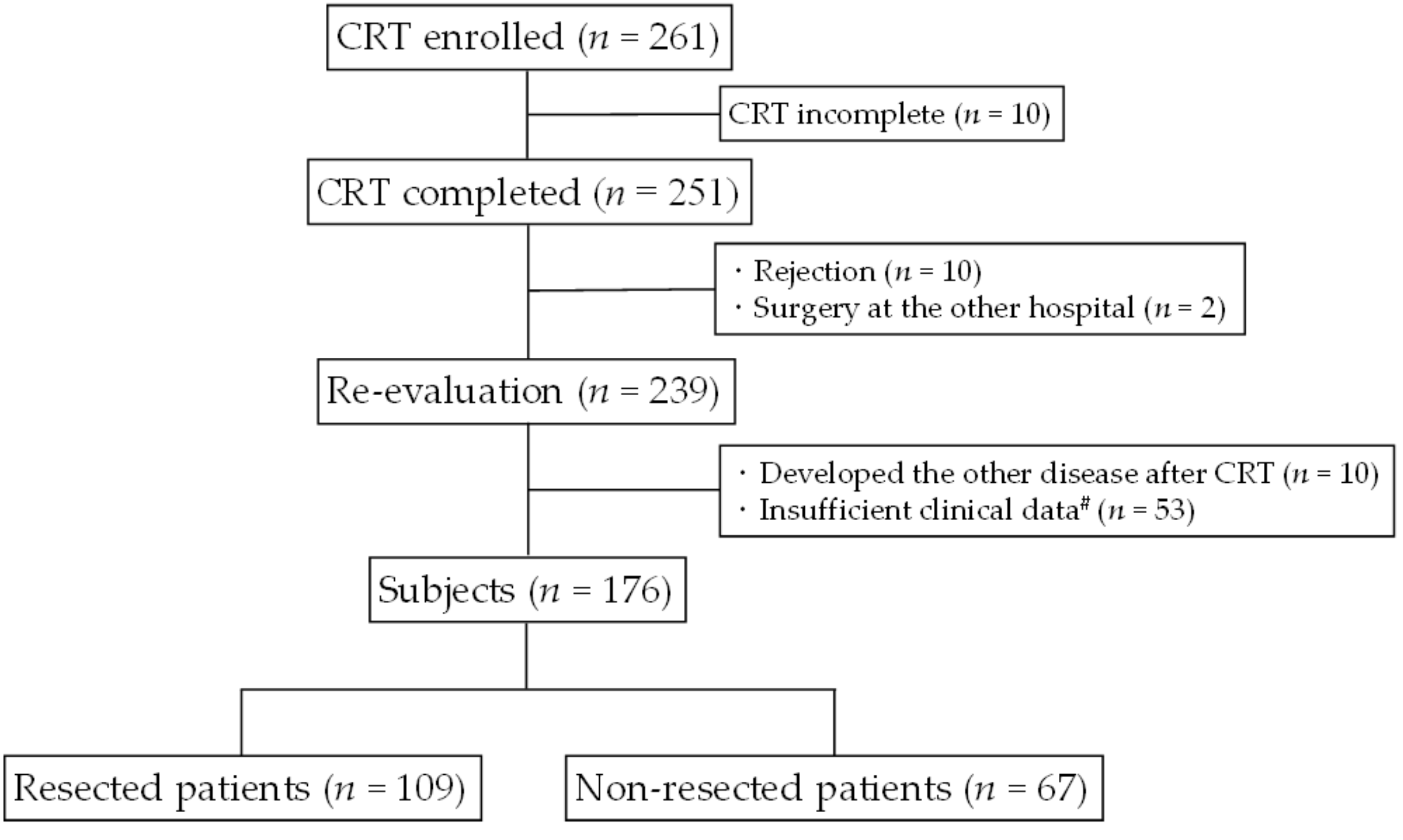
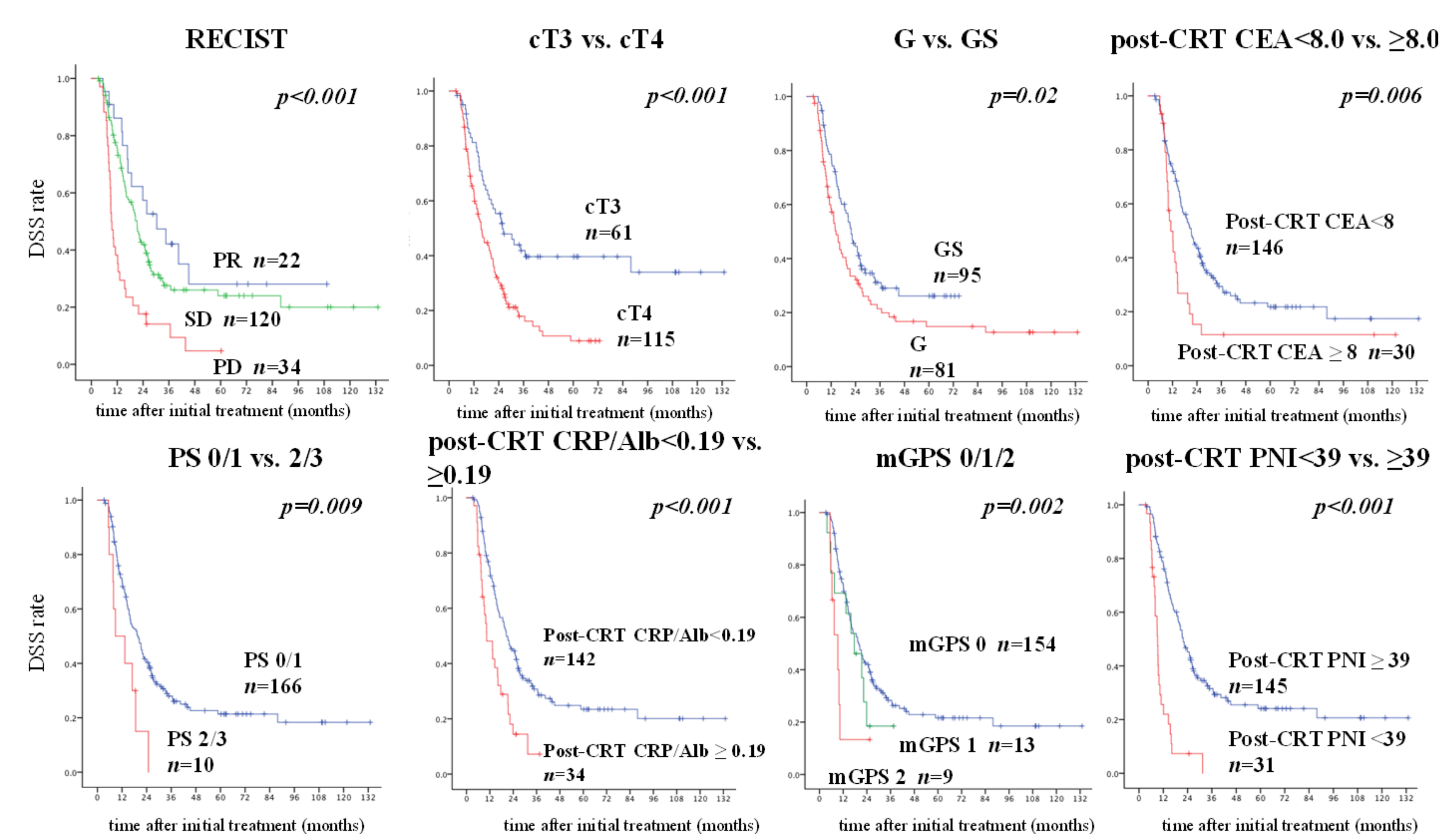
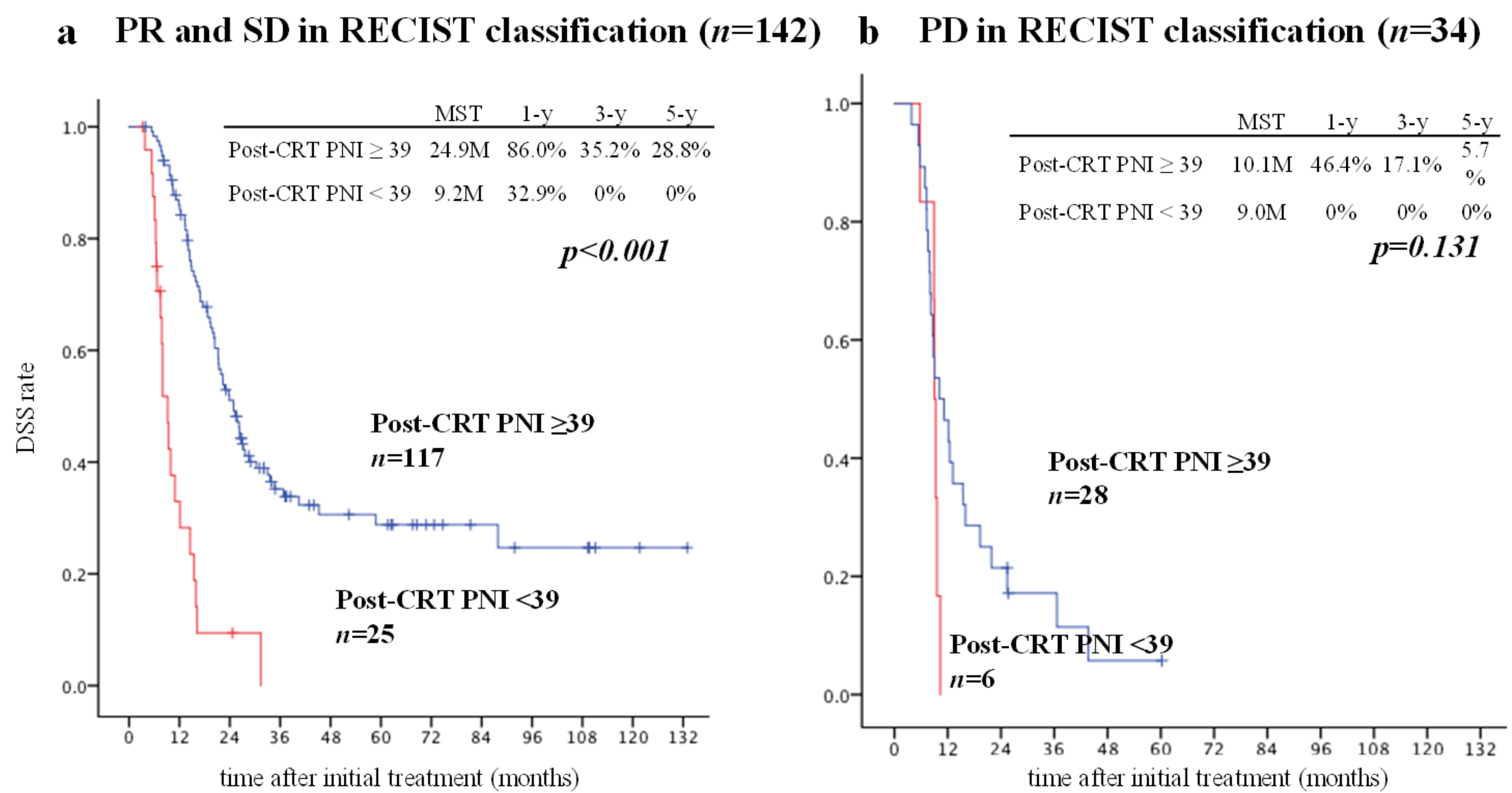
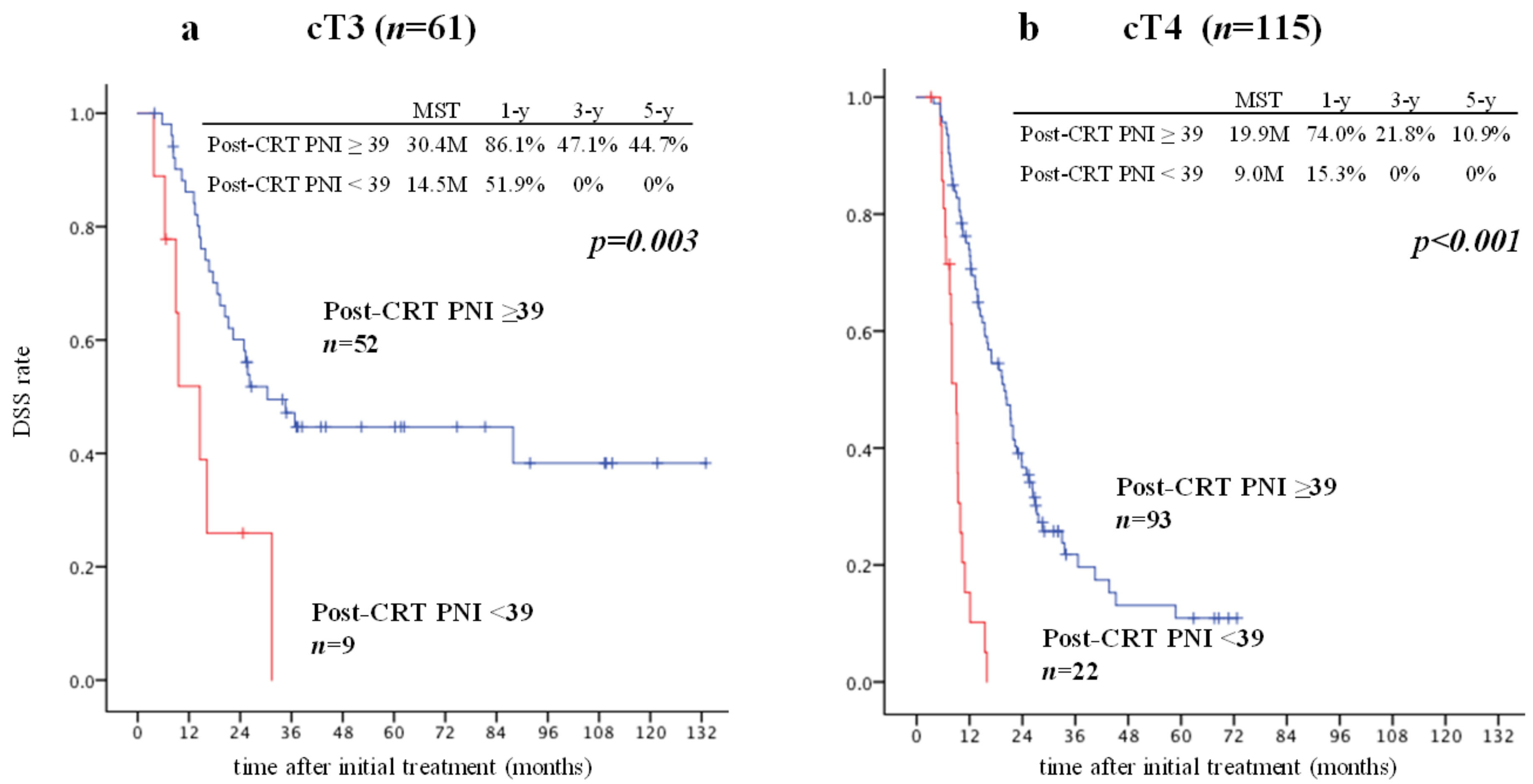
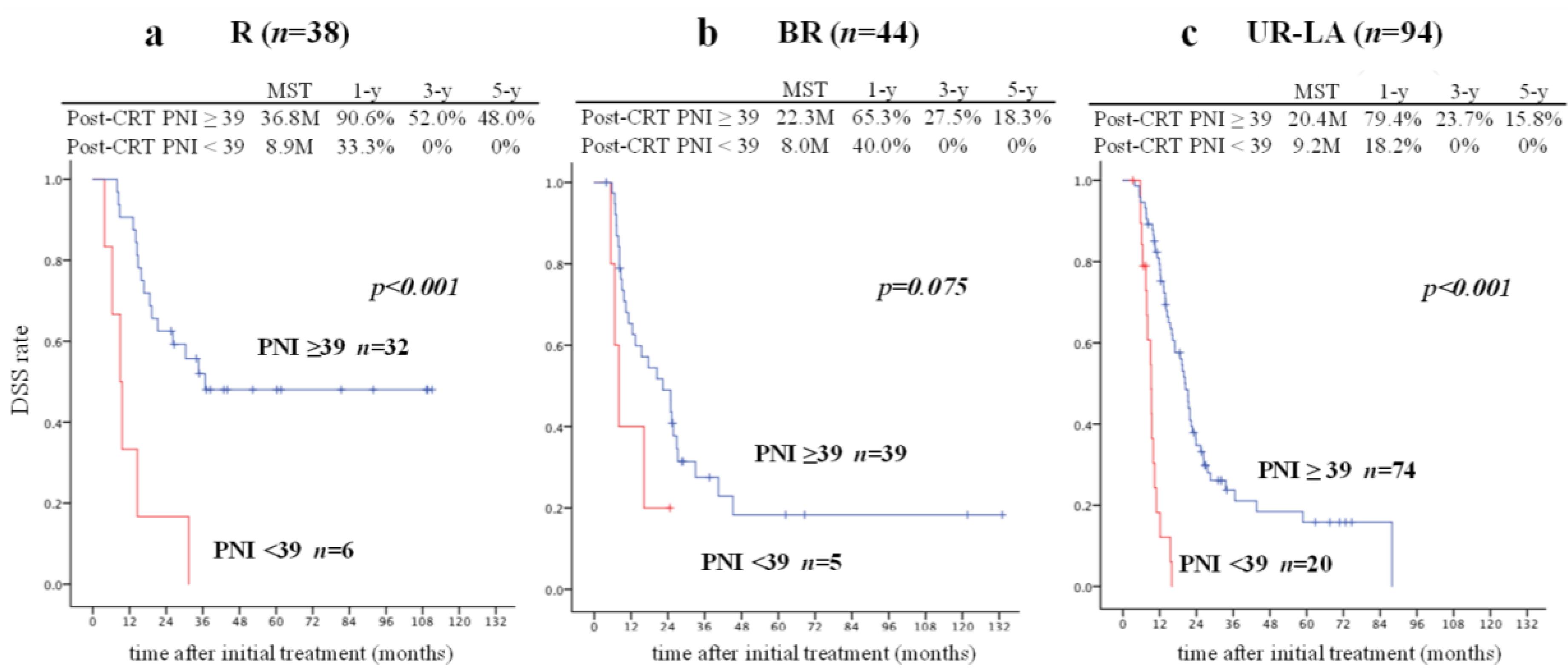
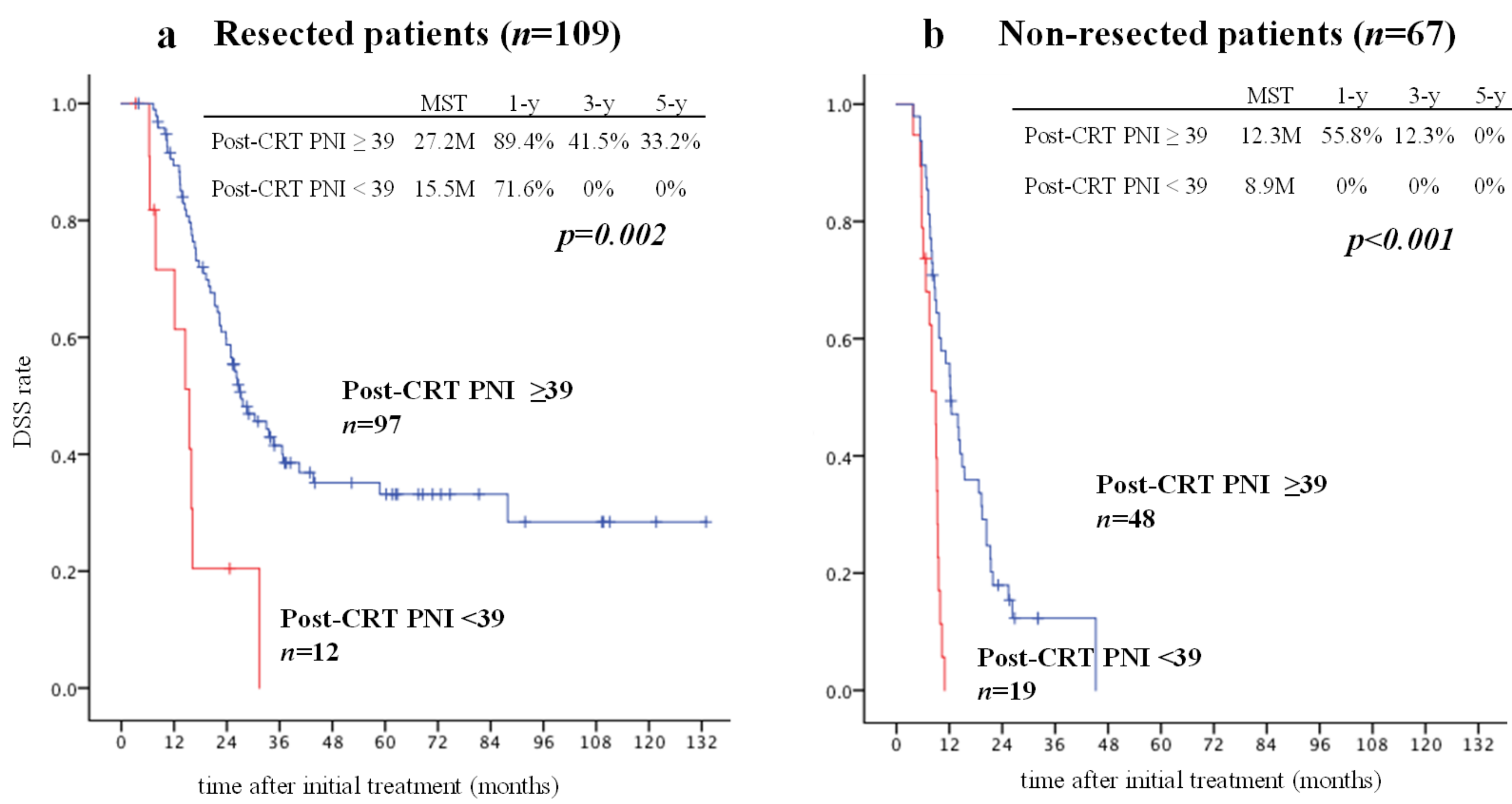
| Characteristic | All Patients (n = 176) | Resected Patients (n = 109) | Non-Resected Patients (n = 67) | p Value |
|---|---|---|---|---|
| Age (year) | 67 (41–86) | 67 (41–86) | 68 (43–84) | 0.547 |
| Sex (male/female) | 116/60 | 68/41 | 48/19 | 0.208 |
| BMI (kg/m2) | 21.1 (15.1–37.8) | 21.1 (15.1–29.4) | 21.4(16.4–37.8) | 0.792 |
| Tumor location (Ph/Pb/Pt) | 123/27/26 | 82/10/17 | 41/17/9 | 0.015 |
| Anatomical factor | ||||
| Resectability (R/BR/UR-LA) | 38/44/94 | 32/29/48 | 6/15/46 | 0.002 |
| cT category (3/4) | 61/115 | 50/59 | 11/56 | <0.001 |
| Biological factor (Pre-CRT) | ||||
| cN category (0/1a/1b) | 124/47/5 | 80/26/3 | 44/21/2 | 0.540 |
| CEA (ng/mL) | 4.8 (1.0–80.5) | 4.4 (1.1–80.5) | 5.2 (1.0–54.0) | 0.381 |
| CA19-9 (U/mL) | 157.6 (0.1–9127) | 125.5 (0.1–9127) | 186.6 (1.0–7770) | 0.221 |
| Conditional factor (Pre-CRT) | ||||
| PS 0/1/2/3 | 106/60/8/2 | 64/39/5/1 | 42/21/3/1 | 0.948 |
| Alb (g/dL) | 4.0 (2.9–4.9) | 4.0 (2.9–4.7) | 4.0 (3.0–4.9) | 0.238 |
| Lymphocytes (/μL) | 1475 (480–3700) | 1510 (540–3700) | 1450 (480–3550) | 0.562 |
| Platelet (×103/μL) | 204 (71–446) | 208 (71–446) | 198 (96–401) | 0.165 |
| CRP (mg/dL) | 0.18 (0–9.10) | 0.20 (0.01–4.87) | 0.16 (0–9.10) | 0.869 |
| CRP/Alb | 0.051 (0–2.76) | 0.052 (0.0025–1.43) | 0.036 (0–2.76) | 0.792 |
| NLR | 2.3 (0.5–9.3) | 2.2 (0.9–7.3) | 2.6 (0.5–9.3) | 0.061 |
| PLR | 133.7 (34.4–440) | 135.1 (34.43–429.6) | 130.1 (38.17–440) | 0.717 |
| GPS (0/1/2) | 145/25/6 | 91/15/3 | 54/10/3 | 0.750 |
| mGPS (0/1/2) | 157/13/6 | 99/7/3 | 58/6/3 | 0.668 |
| PNI | 47.2 (34.6–60.8) | 47.2 (34.6–58.5) | 47.3 (37.3–60.8) | 0.625 |
| Characteristic | All Patients (n = 176) | Resected Patients (n = 109) | Non-Resected Patients (n = 67) | p Value |
|---|---|---|---|---|
| Chemotherapy (G/GS) | 81/95 | 51/58 | 30/37 | 0.795 |
| GEM, mg/m2 | 2688 (496–6425) | 2701 (496–6304) | 2658 (1166–6425) | 0.406 |
| S-1, mg/m2 | 2262 (222–5559) | 2304 (222–5232) | 2196 (615–5559) | 0.366 |
| Radiation 45/50.4 Gy | 99/77 | 69/40 | 30/37 | 0.016 |
| RECIST (PR/SD/PD) | 22/120/34 | 19/83/7 | 3/37/27 | <0.001 |
| Biological factor (Post-CRT) | ||||
| CEA (ng/mL) | 3.9 (1.0–100.6) | 3.6 (1.3–31.9) | 4.6 (1.0–100.6) | 0.131 |
| CA19-9 (U/mL) | 47.8 (1.0–13558.8) | 35.5 (1.0–1474.9) | 94.6 (1.0–13558.8) | 0.005 |
| Conditional factor (Post-CRT) | ||||
| Alb (g/dL) | 3.8 (2.4–4.7) | 3.9 (2.4–4.7) | 3.6 (2.7–4.7) | <0.001 |
| Lymphocytes (/μL) | 995 (380–3210) | 1060 (380–3210) | 1450 (480–3550) | 0.377 |
| Platelet (×103/μL) | 181 (41–423) | 180 (65–423) | 181(41–351) | 0.463 |
| CRP (mg/dL) | 0.17 (0.01–10.93) | 0.14 (0.01–2.76) | 0.18 (0.01–10.93) | 0.068 |
| CRP/Alb | 0.04 (0–2.95) | 0.037 (0.0029–0.73) | 0.052 (0.003–2.95) | 0.041 |
| NLR | 3.0 (0.7–14.6) | 3.0 (0.9–11.0) | 2.9 (0.7–14.6) | 0.776 |
| PLR | 165.2 (36.0–542.1) | 165.1 (47.7–542.1) | 171.6 (36.0–503.7) | 0.948 |
| GPS (0/1/2) | 125/42/9 | 85/22/2 | 40/20/7 | 0.008 |
| mGPS (0/1/2) | 154/13/9 | 96/8/2 | 55/5/7 | 0.041 |
| PNI | 43.4 (29.0–53.9) | 44.9 (29.0–53.5) | 41.6 (31.7–53.9) | <0.001 |
| Characteristic | Pre-CRT | Post-CRT | p Value |
|---|---|---|---|
| Biological factor | |||
| CEA (ng/mL) | 4.8 (1.0–80.5) | 3.9 (1.0–100.6) | 0.012 |
| CA19-9 (U/mL) | 157.6 (0.1–9127) | 47.8 (1.0–13558.8) | <0.001 |
| Conditional factor | |||
| Alb (g/dL) | 4.0 (2.9–4.9) | 3.8 (2.4–4.7) | <0.001 |
| Lymphocytes (/μL) | 1475 (480–3700) | 995 (380–3210) | <0.001 |
| Platelet (×103/μL) | 204 (71–446) | 180.5 (41–423) | <0.001 |
| CRP (mg/dL) | 0.18 (0.01–9.10) | 0.17 (0.01–10.93) | 0.771 |
| CRP/Alb | 0.051 (0–2.76) | 0.04 (0–2.95) | 0.967 |
| NLR | 2.3 (0.5–9.3) | 3.0 (0.7–14.6) | <0.001 |
| PLR | 133.7 (34.4–440) | 165.2 (35.96–542.1) | 0.001 |
| GPS (0/1/2) | 145/25/6 | 125/42/9 | 0.041 |
| mGPS (0/1/2) | 157/13/6 | 154/13/9 | 0.594 |
| PNI | 47.2 (34.6–60.8) | 43.4 (29.0–53.9) | 0.001 |
| Characteristic | Univariable, p | Multivariable, HR (95% CI) | p Value |
|---|---|---|---|
| Age | 0.550 | ||
| Sex; male vs. female patients | 0.476 | ||
| BMI | 0.117 | ||
| Tumor location; Ph vs. Pb vs. Pt | 0.245 | ||
| RECIST; PR vs. SD vs. PD | 0.005 | 0.0011 | |
| Chemotherapy; G vs GS | 0.021 | 1.779 (1.206–2.622) | 0.0036 |
| Anatomical factor | |||
| Resectability; R vs. BR vs. UR-LA | 0.013 | ||
| cT category; 3 vs. 4 | 0.0002 | 0.368 (0.241–0.563) | 0.000004 |
| Biological factor | |||
| cN category; 0 vs. 1 | 0.031 | ||
| Pre CRT CEA | 0.017 | ||
| CA19-9 | 0.095 | ||
| Post-CRT CEA | 0.001 | 1.032 (1.015–1.049) | 0.00016 |
| CA19-9 | 0.038 | ||
| Conditional factor | |||
| PS; 0/1 vs. 2/3 | 0.011 | 0.228 (0.106–0.488) | 0.00014 |
| Pre-CRT Alb | 0.574 | ||
| Lymphocytes | 0.231 | ||
| Platelet | 0.750 | ||
| CRP | 0.047 | ||
| CRP/Alb | 0.052 | ||
| PNI | 0.811 | ||
| NLR | 0.046 | ||
| PLR | 0.599 | ||
| GPS | 0.643 | ||
| mGPS | 0.530 | ||
| Post-CRT Alb | <0.001 | ||
| Lymphocytes | 0.123 | ||
| Platelet | 0.701 | ||
| CRP | <0.001 | ||
| CRP/Alb | <0.001 | 6.771 (2.515–18.23) | 0.00015 |
| PNI | <0.001 | 0.908 (0.869–0.949) | 0.00002 |
| NLR | 0.026 | ||
| GPS | <0.001 | ||
| mGPS | 0.004 | 0.436 (0.246–0.772) | 0.004 |
| PLR | 0.246 |
| Characteristic | Post-CRT PNI ≥ 39 (n = 145) | Post-CRT PNI < 39 (n = 31) | p Value |
|---|---|---|---|
| Age | 67 (41–86) | 70 (49–82) | 0.192 |
| Sex (male/female) | 91/54 | 25/6 | 0.057 |
| BMI | 20.8 (15.1–37.8) | 22.5 (16.7–27.3) | 0.057 |
| Location (Ph/Pb/Pt) | 102/22/21 | 21/5/5 | 0.865 |
| Resectability (R/BR/UR-LA) | 32/39/74 | 6/5/20 | 0.343 |
| cT3 vs. cT4 | 52/93 | 9/22 | 0.470 |
| PS 0/1 vs. 2/3 | 136/9 | 30/1 | 0.515 |
| Chemotherapy (G/GS) | 61/84 | 20/11 | 0.023 |
| G (n = 81) | |||
| Dose of GEM (mg/m2) | 2874 (1890–6425) | 2512 (1165–4262) | 0.005 |
| GS (n = 95) | |||
| Dose of GEM (mg/m2) | 2610 (496–6304) | 2424 (1749–3006) | 0.125 |
| Dose of TS-1 (mg/m2) | 2292 (222–5559) | 1991 (1068–3224) | 0.106 |
| Dose of Radiation 45/50.4 Gy | 81/64 | 18/13 | 0.822 |
| RECIST (PR/SD/PD) | 21/96/28 | 1/24/6 | 0.217 |
| Development of mets after CRT | 17 (11.7%) (R:2, BR:8, UR-LA:7) | 5 (16.1%) (R:2, UR-LA:3) | 0.501 |
| Resected/non-resected (resection rate) | 97/48 (66.9%) | 12/19 (38.7%) | 0.003 |
© 2019 by the authors. Licensee MDPI, Basel, Switzerland. This article is an open access article distributed under the terms and conditions of the Creative Commons Attribution (CC BY) license (http://creativecommons.org/licenses/by/4.0/).
Share and Cite
Ichikawa, K.; Mizuno, S.; Hayasaki, A.; Kishiwada, M.; Fujii, T.; Iizawa, Y.; Kato, H.; Tanemura, A.; Murata, Y.; Azumi, Y.; et al. Prognostic Nutritional Index after Chemoradiotherapy Was the Strongest Prognostic Predictor among Biological and Conditional Factors in Localized Pancreatic Ductal Adenocarcinoma Patients. Cancers 2019, 11, 514. https://doi.org/10.3390/cancers11040514
Ichikawa K, Mizuno S, Hayasaki A, Kishiwada M, Fujii T, Iizawa Y, Kato H, Tanemura A, Murata Y, Azumi Y, et al. Prognostic Nutritional Index after Chemoradiotherapy Was the Strongest Prognostic Predictor among Biological and Conditional Factors in Localized Pancreatic Ductal Adenocarcinoma Patients. Cancers. 2019; 11(4):514. https://doi.org/10.3390/cancers11040514
Chicago/Turabian StyleIchikawa, Ken, Shugo Mizuno, Aoi Hayasaki, Masashi Kishiwada, Takehiro Fujii, Yusuke Iizawa, Hiroyuki Kato, Akihiro Tanemura, Yasuhiro Murata, Yoshinori Azumi, and et al. 2019. "Prognostic Nutritional Index after Chemoradiotherapy Was the Strongest Prognostic Predictor among Biological and Conditional Factors in Localized Pancreatic Ductal Adenocarcinoma Patients" Cancers 11, no. 4: 514. https://doi.org/10.3390/cancers11040514
APA StyleIchikawa, K., Mizuno, S., Hayasaki, A., Kishiwada, M., Fujii, T., Iizawa, Y., Kato, H., Tanemura, A., Murata, Y., Azumi, Y., Kuriyama, N., Usui, M., Sakurai, H., & Isaji, S. (2019). Prognostic Nutritional Index after Chemoradiotherapy Was the Strongest Prognostic Predictor among Biological and Conditional Factors in Localized Pancreatic Ductal Adenocarcinoma Patients. Cancers, 11(4), 514. https://doi.org/10.3390/cancers11040514





